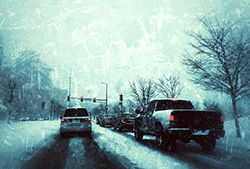How To Maximize Your Vehicle’s Winter Fuel Economy
Whether you’re driving in the summer or winter, you want to maximize your vehicle’s gas mileage. Cold weather can reduce your vehicle’s fuel economy, though. Use these tips to maximize your gas mileage this winter.
Why does Winter Fuel Economy Fall?
When temperatures drop from 70 degrees F to 20 degrees F, your vehicle’s fuel economy can drop by as much as 12 percent. Short trips of less than four miles also cause a fuel economy loss of as much as 22 percent. If you drive a hybrid vehicle, you could experience a 34 percent drop in fuel economy.
These drops occur for several reasons.
- The engine takes longer to reach a fuel-efficient temperature, a factor in fuel economy during shorter trips.
- Idling reduces overall fuel economy.
- Window defrosters, the heater fan and heated seats require extra power.
- Tire pressure decreases, which increases your vehicle’s rolling resistance and reduces fuel economy.
- Cold engine and transmission fluids increase friction.
- Battery performance decreases and affects the battery charge.
- Cold air and snow mounds on your vehicle create a higher aerodynamic drag as you drive at highway speeds.
- Winter grade gasoline blends are lower in energy than summer grade gasoline blends.
- Severe weather reduces tire grip and wastes energy, and slower but safer driving practices lower fuel economy.
How can you Improve Fuel Economy?
If possible, take several proactive steps that increase your vehicle’s gas mileage.
- Park in a garage or other warm location to increase your engine and cabin temperature and reduce the amount of time and effort required to warm the vehicle.
- Allow your vehicle to idle for only 30 seconds. It will warm up almost two times faster and use less fuel as you drive.
- Use defrosters and seat warmers only when necessary. An ice scraper and warmer clothing can help.
- Choose winter tires with low resistance and keep them inflated to the proper pressure as you improve traction and fuel economy.
- Use the cold weather oil recommended by your vehicle’s manufacturer.
- Charge your battery before winter at an automotive store, car dealer or your mechanic.
- Remove accessories like the luggage or ski rack plus accumulated snow since these factors increase wind resistance and reduce your vehicle’s aerodynamics and fuel economy.
- Toss sandbags into the trunk to increase traction.
- Complete as many errands as possible in one trip. Also, check the traffic before your trip and avoid congested or slow areas.
This winter, your car may use more fuel than usual, but you can maximize your vehicle’s fuel economy with these tips.

Comments
Not found any comments yet.